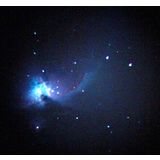


Jupiter has since been explored on several occasions by robotic spacecraft, beginning with the Pioneer and Voyager flyby missions from 1973 to 1979, and later by the Galileo orbiter, which arrived at Jupiter in 1995. Pioneer 10 was the first spacecraft to visit Jupiter, making its closest approach to the planet in December 1973. Ganymede, the largest of these, has a diameter greater than that of the planet Mercury. Jupiter has 80 known moons and possibly many more, including the four large Galilean moons discovered by Galileo Galilei in 1610. Jupiter's magnetic tail is nearly 800 million km (5.3 AU 500 million mi) long, covering the entire distance to Saturn's orbit. Surrounding Jupiter is a faint planetary ring system and a powerful magnetosphere. A prominent result of this is the Great Red Spot, a giant storm known to have existed since at least the 17th century when telescopes first saw it. The outer atmosphere is visibly segregated into several bands at different latitudes, with turbulence and storms along their interacting boundaries. Because of its rapid rotation, the planet's shape is an oblate spheroid it has a slight but noticeable bulge around the equator. The ongoing contraction of its interior generates heat greater than the amount received from the Sun. It likely has a rocky core of heavier elements, but, like the other giant planets, Jupiter lacks a well-defined solid surface. Jupiter is primarily composed of hydrogen, but helium constitutes one-quarter of its mass and one-tenth of its volume.


People have been observing it since prehistoric times it was named after the Roman god Jupiter, the king of the gods, because of its observed size. Jupiter is the third brightest natural object in the Earth's night sky after the Moon and Venus. It is a gas giant with a mass more than two and a half times that of all the other planets in the Solar System combined, but slightly less than one-thousandth the mass of the Sun. Jupiter is the fifth planet from the Sun and the largest in the Solar System.


 0 kommentar(er)
0 kommentar(er)
